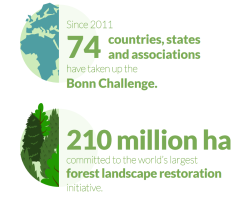- Deforestation and forest degradation are the biggest threats to forests worldwide.
- Over half of the tropical forests worldwide have been destroyed since the 1960s, and every second, more than one hectare of tropical forests is destroyed or drastically degraded.
- The degradation and loss of forests threatens the survival of many species, and reduces the ability of forests to provide essential services.
- Deforestation and forest degradation impact the lives of 1.6 billion people whose livelihoods depend on forests. One billion of them are among the world’s poorest.
- Nature-based Solutions such as forest landscape restoration (FLR) can reverse the effects of deforestation and degradation and regain the ecological, social, climatic and economic benefits of forests.
Biodiversity
Over 80% of the world’s terrestrial biodiversity can be found in forests - from pine trees in the boreal North to the rainforests in the tropics. The degradation and loss of forests threaten the survival of many species, and reduce the ability of forests to provide essential services such as clean air and water, healthy soils for agriculture, and climate regulation.
Sustainable livelihoods
Healthy forests support the livelihoods of 1.6 billion people globally, one billion of whom are among the world’s poorest. Deforestation and forest degradation have real and tangible impacts on the lives of these vulnerable communities. For example, 52 per cent of all land used for food production is moderately or severely impacted by the erosion of healthy soil. This occurs when trees are removed from a landscape, leading to increased food insecurity.
Climate mitigation and adaptation
The world’s forests absorb 2.4 billion tonnes of carbon dioxide (CO2) per year, one-third of the annual CO2 released from burning fossil fuels. Forest destruction emits further carbon into the atmosphere, with 4.3–5.5 GtCO2eq/yr generated annually, largely from deforestation and forest degradation. Protecting and restoring this vast carbon sink is essential for mitigating climate change.
Forests also play a crucial role in climate change adaptation efforts. They act as a food safety net during climate shocks, reduce risks from disasters like coastal flooding, and help regulate water flows and microclimates. Improving the health of these forest ecosystems and introducing sustainable management practices increase the resilience of human and natural systems to the impacts of climate change.





